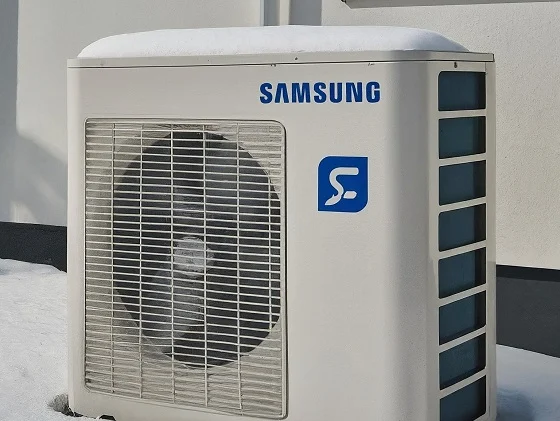 Free delivery on orders over £75 ex VAT
Free delivery on orders over £75 ex VAT Free click & collect from branches nationwide
Free click & collect from branches nationwideDo Air Source Heat Pumps Struggle in Cold UK Weather?
Heat Pumps
Published date: 9 August 2024 / Read time: 5 mins
Air source heat pumps are one of the most energy-efficient ways to heat your home throughout the entire year. Choosing an air source heat pump is one way to guarantee a consistent and reliable home heating system.
Yet, some people have concerns about an air source heat pump's ability to work just as well in cold temperatures. Fortunately, there are several simple steps you can take to ensure an air source heat pump runs smoothly, no matter what the elements throw at it.
Here, the Energy Efficiency team at City Plumbing answers those most frequently asked questions about using your air source heat pump in cold weather.

Can Air Source Heat Pumps Work in Cold Weather?
Yes, they can! It’s possible to enjoy all the benefits of an air source heat pump during cold weather as it is through those milder months. Air source heat pumps are designed to withstand up to at least -10°C. Some are actually durable enough to work at temperatures as low as -25°C. However, with the average UK winter becoming warmer, those cold snaps and big freezes are becoming less common in the UK.
How Efficient Are Air Source Heat Pumps in Winter?
No matter where it’s installed, an air source heat pump's efficiency is determined by the heating demand. So, for example, in a large household that demands large volumes of hot water and constant heating, understandably it might not reach its potential efficiency.
Yet, for cold climates, air source heat pumps remain one of the most efficient home heating solutions. It goes without saying that the unit will need to work a bit harder to heat a house through freezing temperatures seeing as there’s not so much heat in the air at this time of the year for readily absorbing into the home. But, cold weather should not be a deterrent or an obstacle to these devices.
Can a Ground Source Heat Pump Cope With Cold Weather?
Unlike air source heat pumps, ground source heat pumps transfer heat to the home through pipes buried in the garden or outside space. This heat is then absorbed into water as it flows through the pipes, which is then compressed, raising its temperature, before being transferred to the home's radiators or underfloor heating.
So, a ground source heat pump could be more suitable for people living in extreme climates, because even when the ground freezes over, underground temperatures could potentially be at least 10°C higher.

How Should You Use an Air Source Heat Pump in Cold Weather?
It’s a good idea to think about taking several measures to prevent any issues occurring with your air source pump throughout the cold UK weather. By doing so, you can also ensure you get the most out of this fantastic heating system long-term.
- Keep Your Home Well Insulated
If your home isn’t well insulated, an air source heat pump won’t help you save money on your energy bills. When heat is distributed around your home, it shouldn't be able to escape easily. Yet with poor insulation, this will happen, reducing the efficiency of your heat pump.
Look to invest in quality insulation, consider upgrading to double or triple-glazed windows, and work at keeping draughts to a minimum. Look for many ideas on how to insulate your home to ensure you stay cosy as you move through the colder winter months.
- Do Not Cover Your Heat Pump
Though it may be tempting to cover the front of your air source heat pump in a bid to protect it from the worst of the elements, this is not recommended. By covering a heat pump this way, you block the airflow, which then reduces the overall efficiency of the unit and potentially leads to mould.
A better practice is to keep the fans clear and promote a good airflow to the unit. In winter, with certain air source heat pump models, you can activate the defrost mode to prevent the pump from freezing.
- Get Your Heat Pump Serviced Before Winter
By having your air source heat pump checked by a professional before the worst of the weather begins, you can work at keeping it at its optimum performance when you need it most. As many of us know, being without any heating is inconvenient at any time, yet more so in the middle of winter.
The type of servicing for a heat pump will vary depending on the specific model, so it’s worth talking to the experts before deciding who to choose for this task.
- Consider Installing Underfloor Heating
Air source heat pumps will work more effectively when the temperature required to heat the home is lower. So, a potential way to achieve this is to install underfloor heating throughout your space.
Underfloor heating works to distribute warm water across a grid-shaped network of pipes under the floor. The result is a much larger surface area than provided by just a single radiator or heating unit and a more evenly dispersed heat across each room.
- Look At Installing Larger Radiators
Similarly, by replacing those small radiators with larger ones, you can work to reduce the energy required to heat your home. Because of their larger surface areas, the water flowing through larger radiators doesn’t need to be as hot as it would be in smaller radiators when generating the same amount of heat for the room. This ensures your air source heat pump won’t need to work as hard.



